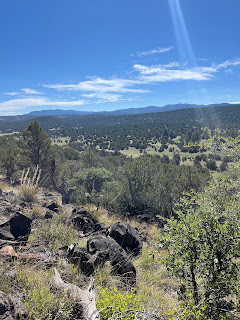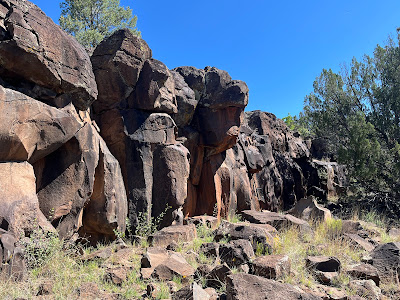 |
| prickly poppy |
We went out to this site a couple of weeks ago (7/3/24). It's a lower elevation hike for the area so it was already getting to be a bit too warm. I'm sure it is too hot right now. The sign for the site, right at the intersection of the primitive road (4177 R) and the well maintained FR 94, was completely obscured by a huge section of a huge ponderosa pine that had fallen across the road to the parking area. At first I wasn't sure what to do. I didn't want to just start walking down the road because I didn't want lengthen the hike any with the morning warming up rapidly and me with two black scottie dogs. Another section of the tree had fallen the other way which seemed to block going around the rather considerable stump. Looking closer though, it seemed that we could just squeeze the 4Runner in between the standing snag and the fallen section, which it what we did.
After parking we started to the left where the trail quickly got rough and steep. Luckily, our older dogs seemed up for the adventure, although they didn't quite understand all the switchbacks.

Soon we were at the cliff face where the trail leveled out and the scrub live oaks provided welcome shade. It was mostly easy walking that had a sweet cozy feel as we looked for petroglyphs and listened (but didn't hear any) for snakes.

The rock art here isn't the best, certainly not in league of the site along the Tularosa River that we visited last year. There isn't a whole lot of it either so you have to keep your eyes peeled if you want to see what's there. Just as I was wondering why the all of the petroglyphs were on the cliff faces and not on any of the abundant broken-off boulders, we came upon two marvelously clear ancient spirals on a large gray angular rock. Unfortunately, immediately adjacent, were someone's painstakingly scratched initials of a much more recent vintage.
There were lovely views of the pine clad mountains the grassy valleys from up top. The descent offered a little more shade than the ascent. All in all it was a nice, but very short, hike. If you go in the summer, get there as early as you can.

Labels: archaeology, big trees, hiking, petroglyphs




















